Troubleshooting Hydraulic Pumps
When a hydraulic issue occurs, the pump usually is one of the first components changed out, but it actually should be the last. Why? Because a pump is the most time-consuming part to replace and the most expensive. It should never be changed before several tests are conducted. The easiest tests and checks should be made first.
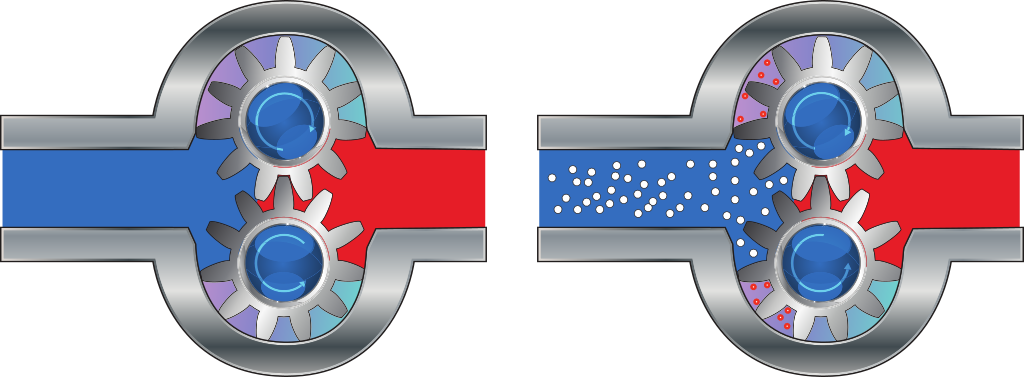
Visual Tests
Is the electric motor running? This sounds like a no-brainer, but it should not be overlooked. I was teaching a class at a plant in Kentucky a few years ago when a student came in one morning and said they had an overheating problem on the press the previous night. He said they changed the filtering and cooling pump to only find out later that the motor had been turned off.
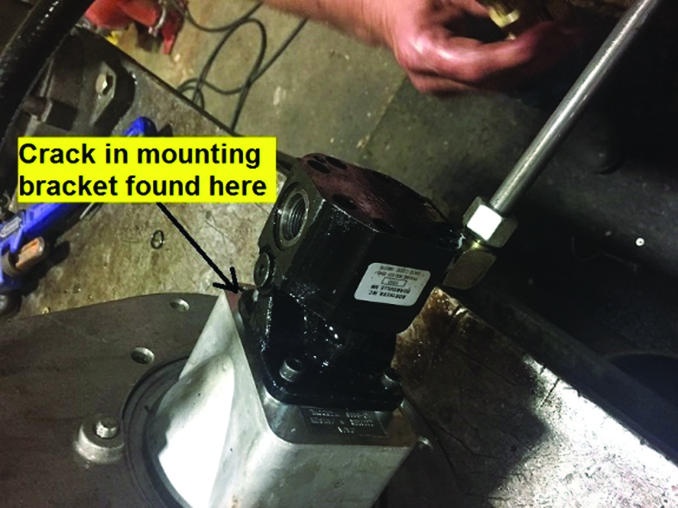 Is the pump shaft rotating? Many times this is difficult to tell because of coupling guards and C-face mounts. I know of one plant where the pressure at the pump outlet port was fluctuating. They changed the pump and found that the worn key on the shaft had damaged the keyway on the coupling.
Is the pump shaft rotating? Many times this is difficult to tell because of coupling guards and C-face mounts. I know of one plant where the pressure at the pump outlet port was fluctuating. They changed the pump and found that the worn key on the shaft had damaged the keyway on the coupling.
Check the oil level. This also should be obvious, as it often is the only thing checked before the pump is changed. The oil level should be 3 inches above the pump suction. Otherwise, a vortex can form in the reservoir, allowing air into the pump.
If the oil level is low, determine where the leak is in the system. Leaks can be difficult to find. A press-roll hydraulic system at a paper mill in South Carolina had a continual problem with low oil levels, but the leak could not be found. The hydraulic unit was in the basement, and the piping ran up through the deck to the roll upstairs. To help find the leak, dye was added to the reservoir. An ultraviolet flashlight and goggles were then used to locate the leak, which was 30 feet in the air just below the second level.
Sound Checks
What does the pump sound like when it is operating normally? Vane pumps generally are quieter than piston and gear pumps. If the pump has a high-pitched whining sound, it most likely is cavitating. If it has a knocking sound, like marbles rattling around, then aeration is probably occurring.
Cavitation
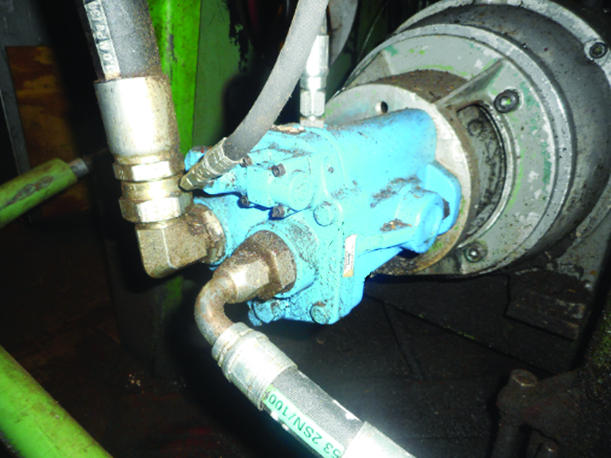 Cavitation is the formation and collapse of air cavities in the liquid. When the pump cannot get the total volume of oil it needs, cavitation occurs. Hydraulic oil contains approximately 9 percent dissolved air. When the pump does not receive adequate oil volume at its suction port, high vacuum pressure occurs. This dissolved air is pulled out of the oil on the suction side and then collapses or implodes on the pressure side. The implosions produce a very steady, high-pitched sound. As the air bubbles collapse, damage is caused inside the pump.
Cavitation is the formation and collapse of air cavities in the liquid. When the pump cannot get the total volume of oil it needs, cavitation occurs. Hydraulic oil contains approximately 9 percent dissolved air. When the pump does not receive adequate oil volume at its suction port, high vacuum pressure occurs. This dissolved air is pulled out of the oil on the suction side and then collapses or implodes on the pressure side. The implosions produce a very steady, high-pitched sound. As the air bubbles collapse, damage is caused inside the pump.
Aeration
Aeration is sometimes known as pseudo cavitation because air is entering the pump suction cavity. However, the causes of aeration are entirely different than that of cavitation. While cavitation pulls air out of the oil, aeration is the result of outside air entering the pump’s suction line.
A number of things can cause aeration, including an air leak in the suction line. This could be in the form of a loose connection, a cracked line or an improper fitting seal. One method of finding the leak is to squirt oil around the suction line fittings. The fluid will be momentarily drawn into the suction line, and the knocking sound inside the pump will stop for a short period of time once the air flow path is found.
Last year I received a troubleshooting call from a paper mill in Wisconsin where one of the pressure-compensating pumps had been changed because it would not build and maintain pressure. When the new pump also did not build pressure, the manual valve in the outlet line was closed to isolate the pump from the system. Pressure still would not build up. Since there were no other valves in the outlet line, the issue had to be in the suction line. After closer inspection, a crack was found in the suction line pipe.
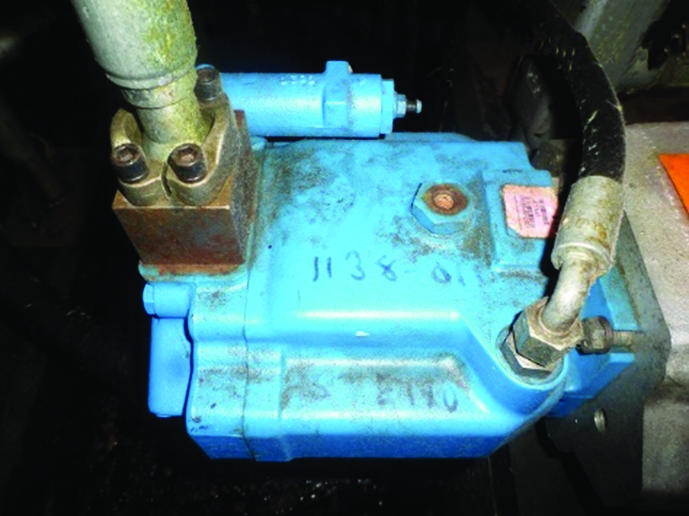 A bad shaft seal can also cause aeration if the system is supplied by one or more fixed displacement pumps. Oil that bypasses inside a fixed displacement pump is ported back to the suction port. If the shaft seal is worn or damaged, air can flow through the seal and into the pump’s suction cavity. This recently occurred on a refiner where the hydraulic pump was used to maintain a precise gap between the discs. Several minutes after the system was turned on, foam started coming out of the reservoir. After the pump was changed, a crack was found in the mounting bracket. This led to the shaft being out of alignment, wearing the seal. A misaligned coupling can cause a shaft seal to wear prematurely as well.
A bad shaft seal can also cause aeration if the system is supplied by one or more fixed displacement pumps. Oil that bypasses inside a fixed displacement pump is ported back to the suction port. If the shaft seal is worn or damaged, air can flow through the seal and into the pump’s suction cavity. This recently occurred on a refiner where the hydraulic pump was used to maintain a precise gap between the discs. Several minutes after the system was turned on, foam started coming out of the reservoir. After the pump was changed, a crack was found in the mounting bracket. This led to the shaft being out of alignment, wearing the seal. A misaligned coupling can cause a shaft seal to wear prematurely as well.
As mentioned previously, if the oil level is too low, oil can enter the suction line and flow into the pump. Therefore, always check the oil level with all cylinders in the retracted position.
If a new pump is installed and pressure will not build, the shaft may be rotating in the wrong direction. Some gear pumps can be rotated in either direction, but most have an arrow on the housing indicating the direction of rotation. Pump rotation should always be viewed from the shaft end. If the pump is rotated in the wrong direction, adequate fluid will not fill the suction port due to the pump’s internal design.
Testing a Fixed Displacement Pump
A fixed displacement pump delivers a constant volume of oil for a given shaft speed. A relief valve must be included downstream of the pump to limit the maximum pressure in the system.
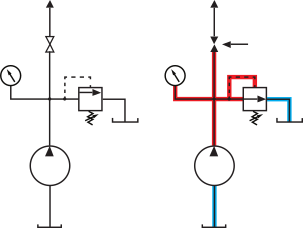 After the visual and sound checks are made, the next step is to determine whether you have a volume or pressure problem. If the pressure will not build to the desired level, isolate the pump and relief valve from the system. This can be done by closing a valve, plugging the line downstream or blocking the relief valve. If pressure builds when this is done, there is a component downstream of the isolation point that is bypassing. If the pressure does not build up, the pump or relief valve is bad.
After the visual and sound checks are made, the next step is to determine whether you have a volume or pressure problem. If the pressure will not build to the desired level, isolate the pump and relief valve from the system. This can be done by closing a valve, plugging the line downstream or blocking the relief valve. If pressure builds when this is done, there is a component downstream of the isolation point that is bypassing. If the pressure does not build up, the pump or relief valve is bad.
If the system is operating at a slower speed, a volume problem exists. Pumps wear over time, which results in less oil being delivered. While a flow meter can be installed in the pump’s outlet line, this is not always practical, as the proper fittings and adapters may not be available.
To determine if the pump is badly worn and bypassing, first check the current to the electric motor. If possible, this test should be made when the pump is new to establish a reference. Electric motor horsepower is relative to the hydraulic horsepower required by the system. This is shown in the following formula: electric motor horsepower (hp) = gallons per minute (GPM) x pounds per square inch (psi) x 0.00067. For example, if a 50-GPM pump is used and the maximum pressure is 1,500 psi, a 50-hp motor will be required. If the pump is delivering less oil than when it was new, the current to drive the pump will drop. A 230-volt, 50-hp motor has an average full load rating of 130 amps. If the amperage is considerably lower, the pump is most likely bypassing and should be changed.
The temperature of the pump housing and suction line should also be checked. A severe increase in temperature indicates a badly worn pump.
Testing a Variable Displacement Pump
The most common type of variable displacement pump is the pressure-compensating design. The compensator setting limits the maximum pressure at the pump’s outlet port. The pump should be isolated as described for the fixed displacement pump. If pressure does not build up, the relief valve or pump compensator may be bad. Prior to checking either component, perform the necessary lockout procedures and verify that the pressure at the outlet port is zero psi. The relief valve and compensator can then be taken apart and checked for contamination, wear and broken springs.
If a volume problem exists in the system, perform the following tests:
Check the tank line temperature of the relief valve with a temperature gun or infrared camera. The tank line should be near ambient temperature. If the line is hot, the relief valve is either stuck partially open or is set too low.
Install a flow meter in the case drain line and check the flow rate. Most variable displacement pumps bypass 1-3 percent of the maximum pump volume through the case drain line. If the flow rate reaches 10 percent, the pump should be changed. Permanently installing a flow meter in the case drain line is an excellent reliability and troubleshooting tool.
Check the current on the drive motor.
Ensure the compensator is 200 psi above the maximum load pressure. If set too low, the compensator spool will shift and start reducing the pump volume when the system is calling for maximum volume.
Performing these recommended tests should help you make good decisions about the condition of your pumps or the cause of pump failures. If you change a pump, have a reason for changing it. Don’t just do it because you have a spare one in stock. Conduct a reliability assessment on each of your hydraulic systems so when an issue occurs, you will have current pressure and temperature readings to consult.
3 Reasons Why a Pump Cavitates
-
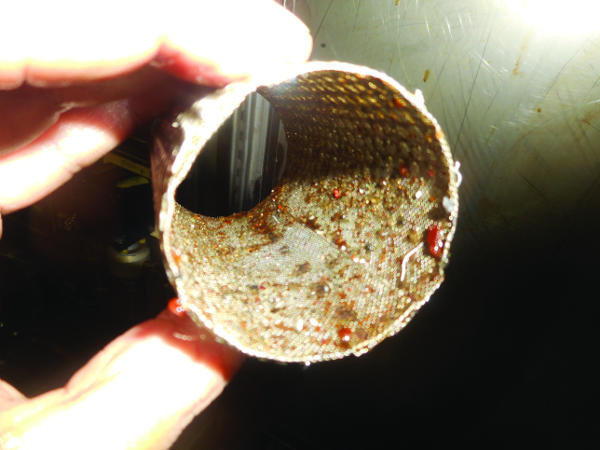 The oil viscosity is too high. Low oil temperature increases the oil viscosity, making it harder for the oil to reach the pump. Most hydraulic systems should not be started with the oil any colder than 40 degrees F and should not be put under load until the oil is at least 70 degrees F. Many reservoirs do not have heaters, particularly in the South. Even when heaters are available, they are often disconnected. While the damage may not be immediate, if a pump is continually started up when the oil is too cold, the pump eventually will fail prematurely.
The oil viscosity is too high. Low oil temperature increases the oil viscosity, making it harder for the oil to reach the pump. Most hydraulic systems should not be started with the oil any colder than 40 degrees F and should not be put under load until the oil is at least 70 degrees F. Many reservoirs do not have heaters, particularly in the South. Even when heaters are available, they are often disconnected. While the damage may not be immediate, if a pump is continually started up when the oil is too cold, the pump eventually will fail prematurely. -
The suction filter or strainer is contaminated. The strainer typically is 74 or 149 microns and is used to keep “large” particles out of the pump. The strainer may be located inside or outside the reservoir. Strainers located inside the reservoir are out of sight and out of mind. Many times maintenance personnel are not even aware that there is a strainer in the reservoir. The suction strainer should be removed from the line or reservoir and cleaned a minimum of once a year. I was called in to help a plant troubleshoot a system where they had already changed five pumps in a week’s time. I noticed that the breather cap was missing, which was allowing dirty air to flow into the reservoir. A check of the hydraulic schematic showed a strainer in the suction line inside the tank. When the strainer was removed, a shop rag was found wrapped around the screen mesh. Apparently, someone had used the rag to plug the breather cap opening, and it had then fallen into the tank.
-
The electric motor is driving the hydraulic pump at a speed that is higher than the pump’s rating. All pumps have a recommended maximum drive speed. If the speed is too high, a higher volume of oil will be needed at the suction port. Due to the size of the suction port, adequate oil cannot fill the suction cavity in the pump, resulting in cavitation. Although this rarely happens, some pumps are rated at a maximum drive speed of 1,200 revolutions per minute (RPM), while others have a maximum speed of 3,600 RPM. The drive speed should be checked any time a pump is replaced with a different brand or model.
